Neil Morrison | February 24, 2020
With its varying temperatures, humidity and wind speeds, preseason testing at Qatar’s sparse Losail International Circuit has a habit of throwing up a surprise or two. But as the commencing of the 2020 MotoGP Championship is now less than a fortnight away, the final outing of the preseason gave an early indication of how the season’s early races may play out.
Notably, the apparent strengths of Yamaha and Suzuki were on show, the series’ two manufacturers developing their inline-four-cylinder engines to the point of maximum expression. Ecstar Suzuki’s Alex Rins and Joan Mir were first and second on day one, while Petronas SRT Yamaha’s Fabio Quartararo topped the field on the second evening.
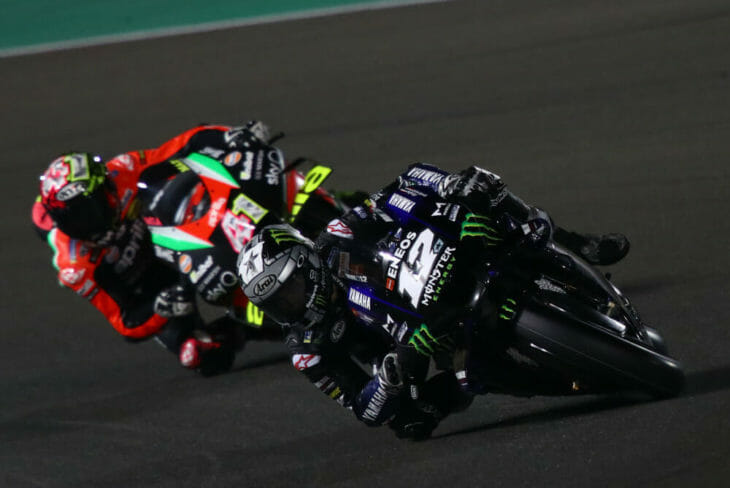 Vinales fired the final preseason shot in Qatar, going fastest for Monster Energy Yamaha.
Vinales fired the final preseason shot in Qatar, going fastest for Monster Energy Yamaha.
By the close of day two, the lap charts made for exciting reading. In terms of pace barely anything separated the Suzukis, Quartararo and Monster Energy Yamaha’s Maverick Viñales, who was posting laps consistently in the 1m 54s (last year’s race pace). As early as the season is, this could be a snapshot of the class’ new school that is most likely to push reigning world champion, Marc Marquez, in years to come.
Both Yamaha and Suzuki have made small, subtle steps from 2019. The M1 and GSX-RR turn better than any other package, while both have made minor improvements to top speed. Crucially, Michelin’s new rear tire for 2020—boasting more edge grip and greater durability—is well suited to their needs. Even Valentino Rossi, now in his 41st year, was upbeat on Sunday, declaring himself “quite ready for the start.”
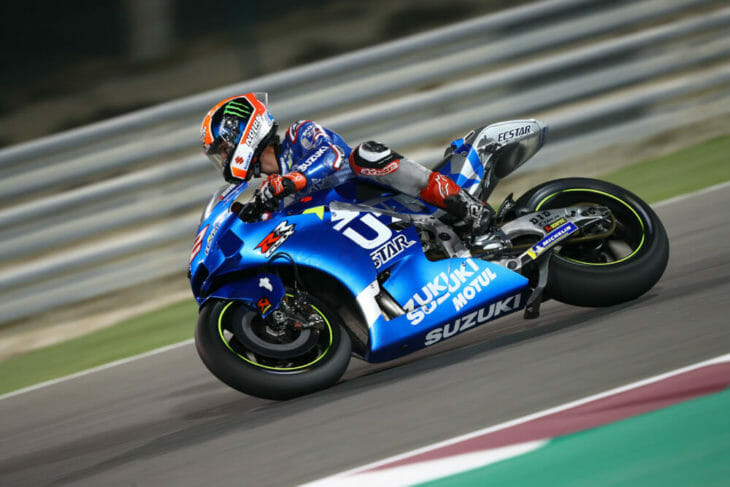 Rins’ consistently strong pace in the Sepang and Qatar test is a good sign for the improving Suzuki team.
Rins’ consistently strong pace in the Sepang and Qatar test is a good sign for the improving Suzuki team.
The smiles and quiet confidence expressed by their riders were a contrast to the long faces within HRC’s ranks. Fast crashes for Marquez (turn eight) and Cal Crutchlow (turn two) on day two were just the start of it. The chassis remains as critical as ever, offering little in the way of front-end feel. What’s more, Losail’s long, fast corners acted as the bike’s kryptonite; that front instability caused the tire to skip and skate, putting stress on rubber and rider alike.
Privately team members have expressed massive frustration that the 2020 RC213V has retained the flaws of its predecessor. Honda has built another formidable engine, with even better grunt than the ’19 model. But Crutchlow didn’t even attend his media duties on Sunday evening such was his disgust at the day’s events. As the Yamahas and Suzukis rolled of laps in the 1m 54s with ease, Marquez struggled to get within a second of those times. Crutchlow, meanwhile, was much worse off, a further second slower than the reigning champion.
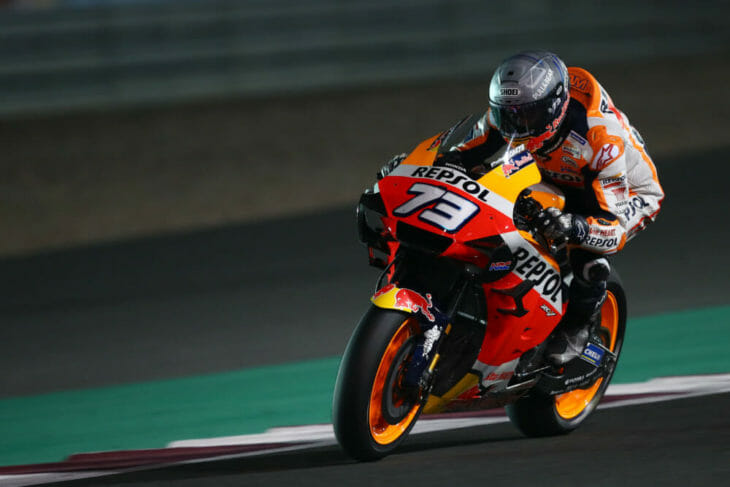 Alex Marquez found the going tougher in Qatar, finishing down in 21st.
Alex Marquez found the going tougher in Qatar, finishing down in 21st.
Historically Honda has never fared well at this test. The factory was close to full-blown crisis here in 2016 before Marquez found a way to turn it around and win two of that season’s opening three races. Let it not be forgotten that Crutchlow left this three-day affair with the 17th fastest time at this point a year ago before returning to an emotional podium at the same track two weeks later. But Marquez is still fighting the effects of major surgery on his right shoulder. An aggravated nerve is still causing him pain three months on and he lacks the upper body strength to rescue front end slides he saved with such miraculous regularity in the past.
Pinning its hopes on Marquez overcoming these odds is a risky tactic that worked in the past. But on this evidence, the likelihood of him matching last season’s stellar feats appear slim. Such were their struggles with the 2020 bike HRC engineers drafted in one of Takaaki Nakagami’s ’19-spec bikes to for him to ride on the final day. “Of course I’m worried because I would like to be very fast on every lap at every race track. But in this race track all Honda riders, especially with the new bike, we are struggling a lot in the same point.” Even so, only a fool would write him off now.
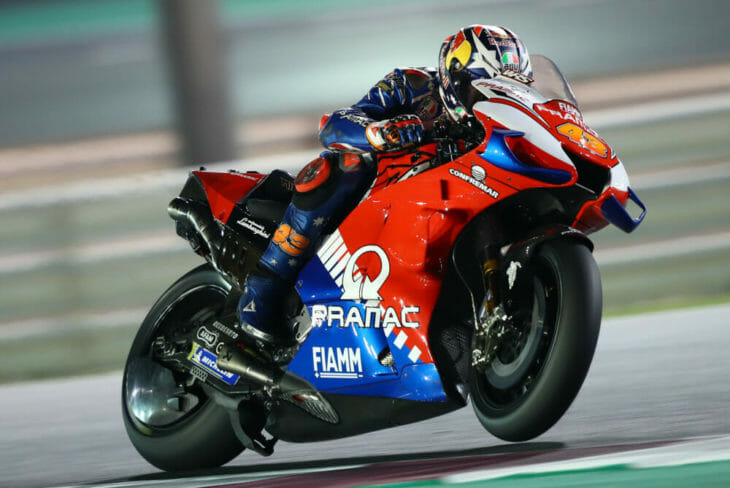 Jack Miller and his “ballistic missile” Ducati finished the test an impressive fifth fastest.
Jack Miller and his “ballistic missile” Ducati finished the test an impressive fifth fastest.
Lap times aside, the test’s big talking point was the latest of Gigi Dall’Igna’s radical innovations. Ducati’s new device was the talk of the town as photographers’ pictures and rider comments confirmed what Rins had suspected at Sepang: the Desmosedici’s ride height can be manually adjusted between bends. The rear of Jack Miller’s machine was seen to be squatting on the corner exit before returning to normal height at the end of a straight.
Technical Director Dall’Igna has developed a system whereby the rear shock appears to be locked in place by a switch on the left of the riders’ handlebar. When engaged on corner exit ride remains low, working as an effective wheelie control. As the switch is hydraulic and doesn’t operate electrically, it was deemed legal by series Technical Director Danny Aldridge.
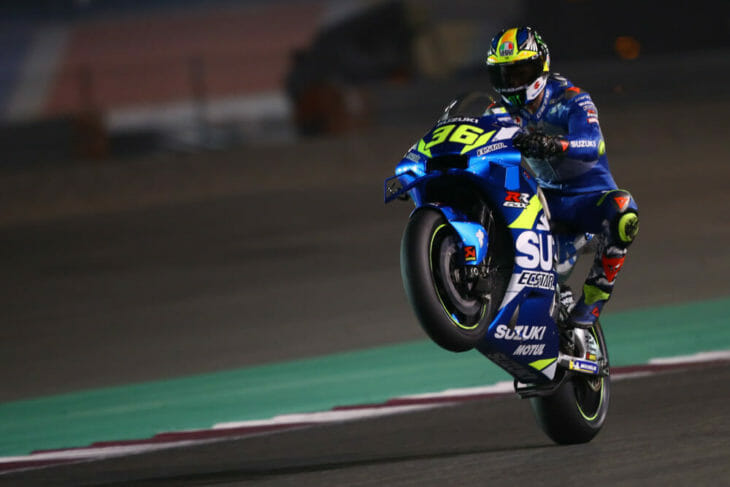 Mir is looking good at the start of his second season in MotoGP.
Mir is looking good at the start of his second season in MotoGP.
“As soon as we put it on there, it makes a bit of a difference in every way,” said Miller, who confirmed he has been using the device since last October’s Thai Grand Prix. On where the difference is most pronounced he noted, “Accelerating. [There’s] Less wheelie. [It’s] Like the launch control, but out of a corner.” Bagnaia added, “The problem is that you have a very short time from one corner to the next on a MotoGP bike, and you arrive at 190mph. I have to learn so [I can operate it] automatically.”
New device or not, Ducati is some way off where it needs to be. Factory runners Dovizioso and Petrucci were eighth and 12th at the close of day two. Crucially that age-old turning deficit remains, with the former saying, “Still the middle of the corners is our [weak] point.” Miller topped the speed charts on days one and two, peaking at a pupil dilating 218mph. “My thing is a ballistic missile,” he said. But its turning deficiencies were a crucial weakness last year. It will be an uphill task to consistently battle Marquez, Yamaha and Suzuki in such a state.
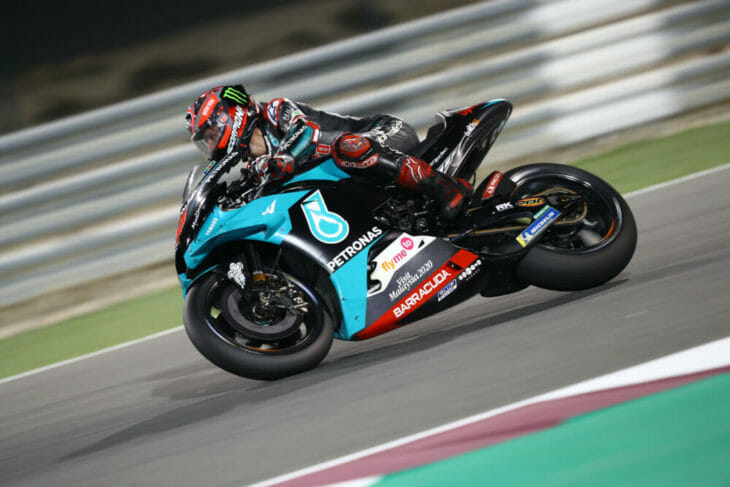 Fabio Quartararo expects to be fighting for race wins from the first round to the last in 2020
Fabio Quartararo expects to be fighting for race wins from the first round to the last in 2020
A sign of Ducati’s struggles was how close Pol Espargaro’s KTM was to the Bologna bikes. The Austrian factory has edged closer to the front after another winter of tireless work. “Working for Sunday, not for Saturday” was his motto here with his pace a match for the group behind the front four. “We are turning a bit better and also the engine is helping. The new rear tire helped us. It keeps our bike more stable at the end of the race. We got more top-speed and the acceleration, which is nicer, smoother and I am not as tired from riding the bike as before.”
Two weeks is a long time in motorsport, as Aleix Espargaro can attest. The Catalan left Sepang declaring Aprilia’s all-new 2020 RS-GP was ready for the podium. But here the machine was erratic in performance (Espargaro was fast on Saturday afternoon before losing traction in the evening; the opposite occurred on Sunday) while concerns regarding its reliability must have factory bosses sweating. “It’s quite normal that we have some problems with the new stuff coming because everything is new. The engineers need to understand what’s happening on that bike.” Neil Morrison
2020 Qatar MotoGP Test Results
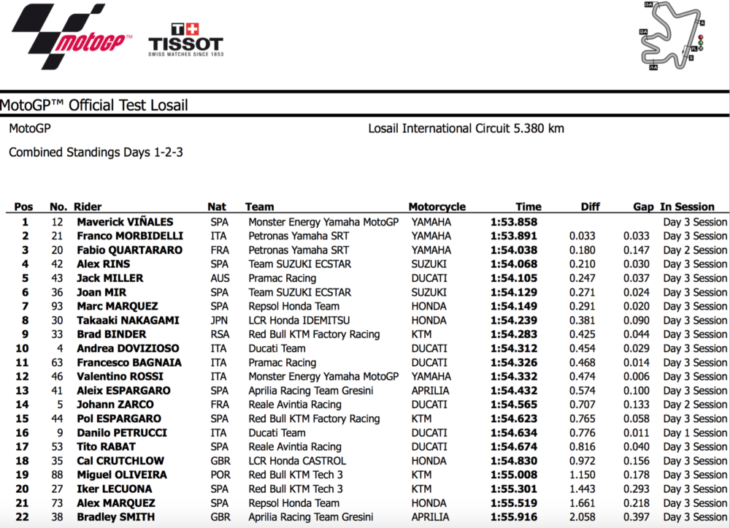
For all the latest MotoGP news and results, click here